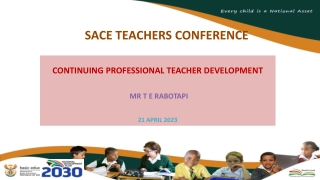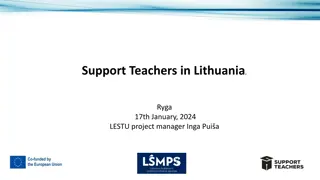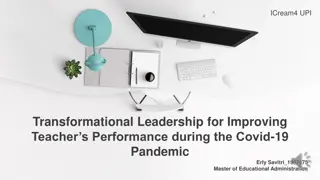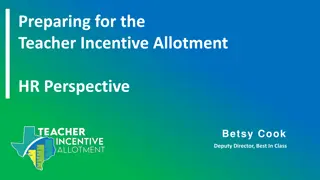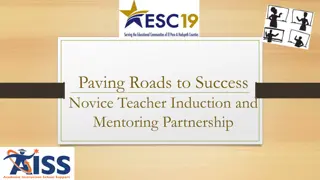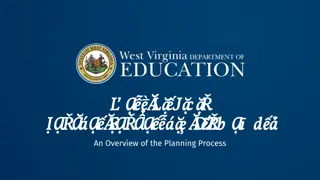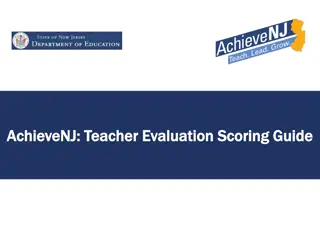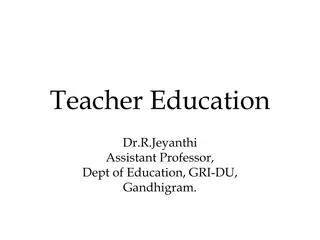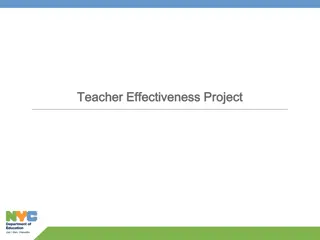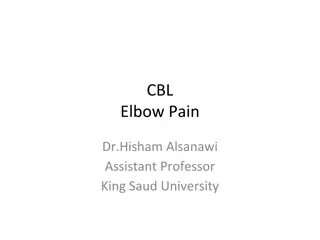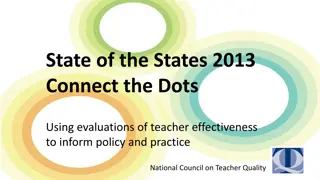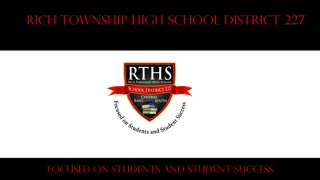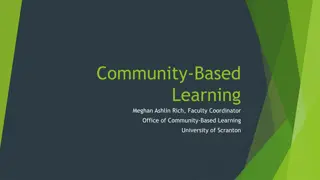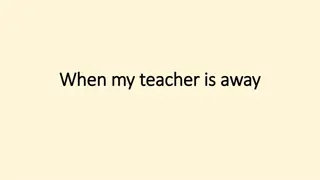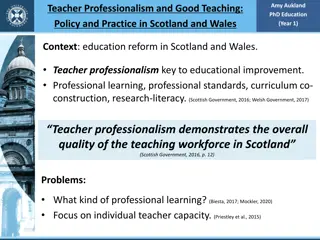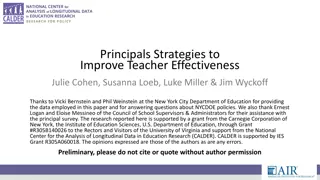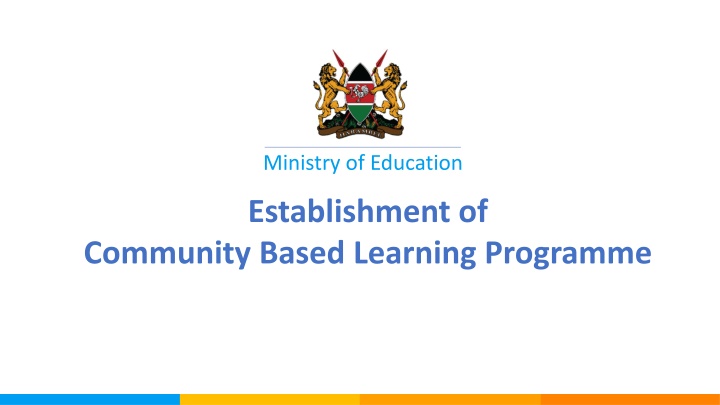
Implementing Community-Based Learning Programme in Collaboration with Government Agencies
The Ministry of Education, in coordination with government agencies, is establishing a Community Based Learning Programme to engage learners during the COVID-19 pandemic. This initiative involves setting up committees, mapping learners and teachers, identifying venues, and ensuring supervision and monitoring. Learn more about this innovative approach to education.
Uploaded on | 1 Views
Download Presentation

Please find below an Image/Link to download the presentation.
The content on the website is provided AS IS for your information and personal use only. It may not be sold, licensed, or shared on other websites without obtaining consent from the author. If you encounter any issues during the download, it is possible that the publisher has removed the file from their server.
You are allowed to download the files provided on this website for personal or commercial use, subject to the condition that they are used lawfully. All files are the property of their respective owners.
The content on the website is provided AS IS for your information and personal use only. It may not be sold, licensed, or shared on other websites without obtaining consent from the author.
E N D
Presentation Transcript
Ministry of Education Establishment of Community Based Learning Programme
Introduction The Ministry of Education and TSC using a multi-agency approach and in collaboration with Ministry of Interior and Coordination National Government through the Nyumba Kumi initiative will implement the community based learning as from September 2020.
Introduction Cont. This is a follow up to extensive consultations with all stakeholders in the Education sector on community- based learning as a means of engaging learners during the current period of Covid 19 pandemic
Introduction Cont. To enable smooth running of the programme, detailed Guidelines have been developed to facilitate the roll out of the programme The guidelines will cover establishment of Community Based learning committees, mapping of learners, mapping of teachers, identification of venues, content and assessment as well as supervision and monitoring
What is community based learning? Community based learning approach is where learners are meaningfully engaged to learn within their communities. The purpose of establishing community based learning is to engage learners during the COVID 19 schools closure.
Establishment of CBL Implementation Committee Composition of CBL Committees The implementation of community based learning will be done by multispectral committees based at the County level, Sub County level and the Zone.
Establishment of CBL Implementation Committee Cont. The committees will draw their membership from the following government agencies: Ministry of Education Teachers service commission Ministry of Health Ministry of Interior and Coordination of National Government County Government
County community based learning committee The county committee will consist of the following members County Commissioner Education CEC County Director of Education TSC County Director County Quality Assurance Officer County Ministry of Health Officer
County Community Based Learning Committee The county committee will be co-chaired by the County Director of Education and the TSC County Director. The role of the County CBL committee Monitor the implementation of CBL Receive weekly reports on CBL from the sub county Submit Weekly report to MOE
Sub County CBL committee The county committee will consist of the following members Deputy County Commissioner Sub County Director of Education TSC Sub County Director Sub County Quality Assurance Officer Sub County Ministry of Health Officer The Sub County Committee will be co-chaired by the Sub County Director of Education and TSC Sub-county.
The role of the Sub County CBL committee Establishment of the zone committees. Oversee mapping of teachers at the zone Oversee mapping of learners at the zone Oversee Identification of venues Assess the suitability of identified venues Monitor the implementation of CBL Receive weekly reports on CBL from the Zone Submit weekly reports to the County office
Zone CBL committee The Zone committee will consist of the following members Curriculum support officer Area Chief Ministry of Health Officer Nyumba kumi initiative leaders The Zonal committee will be coordinated by the Ministry of Education and chaired by the CSO.
The role of the Zone CBL committee Sensitize the parents and community on the CBL programme Orient teachers on the programme Identify the venues and assess their suitability for learning Map learners in the Nyumba Kumi area within the zone Allocate teachers to the learners in their respective Nyumba kumi area Supervise the implementation of CBL at the zone Submit weekly reports to the Sub County office
Mapping of Learners Mapping of Learners The zonal implementation committee shall carry out the following: Sensitize the parents within the Nyumba Kumi and the community Allocate learners to identified venues. Allocate teachers to venues. Orient the teachers. Supervise the implementation of CBL.
Mapping of Learners Cont. 1.The chiefs will assist in making sure that all the learners within their areas of jurisdiction participate in the program. 2.Where there are already existing on line learning programs the CBL committees should take note and monitor learner engagement. The committee will maintain the following: An accurate record of all learners mapped Record of activities planned for and implemented. Records of teachers implementing the program.
Identification of Venues The zonal CBL committee will identify the venues on the following parameters: Identify venues and assess their suitability guided by the MOH protocols. All venues should be public and free of charge for use. Identification of venues should be in consultation with the relevant stake holders. All the venues should be child friendly in terms of location and use (schools, churches, social halls, open spaces etc) The venues should be within comfortable walking distance for the learners. The venues should be spacious enough to allow for social distancing (1.5m space between learners) The chief and local administrators should ensure security of learners to, within and from the venues. Unauthorised persons should be kept away from the venues.
Mapping of Teachers All teachers employed by the Commission are directed to register with the Curriculum Support Officers and Sub County Directors within Zones and Sub- County where they are currently staying in by 12th August 2020 with a view to undertaking community based learning which has been identified as a means of engaging learners during the current period when schools are closed as a result of the COVID 19 pandemic. 17
Teachers will play a pivotal role to ensure the success of the programme. In this respect, teachers will be expected to carry out the following activities:- 18
Activities teachers will carry out Heads of institutions should be in school at least once per week to supervise and monitor the programme. Utilize the Nyumba Kumi programme to ensure that all learners participate in the programme. Set up a face to face programme of engaging not more than 15-20 learners while strictly observing the Ministry of Health Guidelines and protocols. This engagement should be at least 4 Hours a day at no charge. 19
Activities Activities cont cont Organize the learners as much as possible according to their classes and/or age groups to ensure that the themes under discussion are relevant, suitable and appropriate to the group. Sensitize and educate the learners on the guidelines and protocols issued by the Ministry of Health towards the containment of the Covid-19 pandemic. 20
Conduct remote daily or weekly follow up with learners and parents. Utilize local resources during learners' engagement. Offer guidance and counselling and psycho-social support to learners. Monitor the progress and the status of learners and provide information to Curriculum Support Officers. Code of regulations for teachers and Code of conduct and Ethics for Teachers shall prevail. 21
Enhancing Engagement in Online Teaching In order to enhance engagement on online teaching teachers should carry out the following activities: i. Make Learning as interactive as possible ii. Communicating the learning expectations to learners iii. Use peer-to-peer networks to your advantage iv. Emphasize self-guided learning (particularly with less experienced students) 22
i. Make Learning as interactive as possible Emphasis should be placed on modern pedagogical practices, like group work, peer feedback and blended or blended' learning. These activities can be conducted online and may help to extend students' attention spans. 23
ii. ii. Communicating the learning expectations to learners There is need to have learners understand the learning expectations as there are many factors that can affect engagement in teaching from home situations (learners may be living with family members who impact engagement) to technology problems (learners may have older technologies or slower internet speeds) to different learning styles. 24
. . Orientation and/or induction of CBL implementation committees will be carried out through a multi-agency approach (Ministry of Education, Ministry of Interior and Coordination of National Government, Ministry of Health and the Teachers Service Commission) Briefing will entail the content and activity areas as detailed below. 25
Community Based Learning suggested task based activities for engaging learners The suggested learning activities are not meant to cover the curriculum designs or syllabuses but to engage learners to gain good personal habits, competencies, skills and values. The activities have been outlined for the teachers but it is imperative that they be creative and include other activities that will be fun and enjoyable for the learners. The activities should be varied to reduce monotony and keep the learners interested.
Suggested learning activities Suggested learning activities The suggested activities should: be non-contact allow for social distancing be interesting and engaging comprise short interval lessons require learners to do some practical work allow for creativity, improvisation and use of locally available materials allow learners to express themselves freely, for example develop showcase portfolios, display of talents, dramatize, draw, song and dance.
suggested learning activities Primary School The suggested learning activities will be based on the following themes: 1. Life skills and values; 2. Health and fitness; 3. Learning area activities; 4. Environment and sanitation.
Suggested learning activities Cont. Secondary School The suggested learning activities will be based on the following themes: 1. Citizenship 5. Games and Fitness 2. Environment 6. Life skills 3. Creative arts 7. Home science 4. Languages 8. Mathematics and financial literacy
Suggested broad areas Citizenship Environment Creative Arts Language Personal Hygiene Language games Values Formation Multi - media cards Hygiene and Conservation Debates Social Responsibility Draw and paint Careers in Science Public speaking Social pictures (Non)Communicable Diseases Poetry Craft activities Entrepreneurship Body Systems Oral Literature Religious Activities Music and dance Physical Exercise and Safety Reading Socio-cultural Drama Home Remedies and Simple First Aid Writing Videography and Activities. Environmental Conservation photography Business Resources Agribusiness
Suggested broad areas Cont. Games and fitness Life skills Home science Mathematics and Financial literacy Personal hygiene Clothes Foods Care of the home and compound Consumer awareness Self-aware Stop Bullying and Violence Time Management Making decisions Leadership Communication Self-esteem Conflict resolution Choosing subjects and careers Study and organisational skills, Goal setting Daily Living Skills Mathematics Geometry shapes Math Brain Teasers Trick Questions Riddles Ratios and Proportions The Number System Expressions and Equations Running games Dancing Athletics Aerobics ensure social distancing Financial Education Self-assessment Self -discovery
Suggested Reference/Teaching and Learning Materials 1. Teachers should plan around learning activities that do not involve too much of text books. They therefore need to engage in hands on experiences requiring the learners to perform certain tasks. 2. Old newspapers and magazines can be used. Take note that the materials should be not shared. 3. Guide learners on responsible use of tablets and other electronic devices. 4. Teachers can make prior arrangements to access books and other materials from the nearby schools provided there is a good issuance, maintenance and return procedures.
Supervision and Monitoring Supervision of CBL In order to ensure successful engagement of learners in the CBL programme, the Zonal committees shall Ensure the CBL programme runs from Monday to Friday from 9.00am to 1.00pm Make visits to the CBL learning venues during the learning time to ensure its successful implementation areas of jurisdiction. Support the teachers and demonstrate the suggested learning activities Receive feedback reports from teachers on the implementation of the CBL Compile weekly reports Offer continuous support on any emerging issues and continuously liaise with Sub- County and County Committees.
Monitoring Monitoring shall be conducted through multi-agency approach at all levels. This will be conducted regularly so as to offer support and provide timely solutions to any emerging issues that may hinder the implementation of the programme.
Monitoring Template Administrative details Centre name: Zone: Sub County: County: Name of teacher: TSC no: No of learners mapped for the centre No of learners present
Monitoring Template Cont.. Area (E.g. Venue, Activities, Attendance etc.) Findings Challenges Recommendations /Mitigation measures Action by Name of the Monitoring Officers .. Designation Signature Date ..
Monitoring Report Format The County CBL Committee shall prepare monthly reports which shall be forwarded through the Regional Directors to the Cabinet Secretary, Ministry of Education and The Secretary Teachers Service Commission not later than the fifth day of the subsequent month.
Report Format Title: Monitoring report on community service learning for .region for the month of Preamble (include number of monitored centers and counties) Attendance (leaners and teachers attendance trends) Successes Challenges Conclusion and Recommendations


